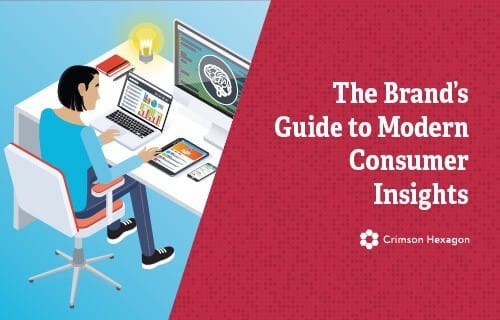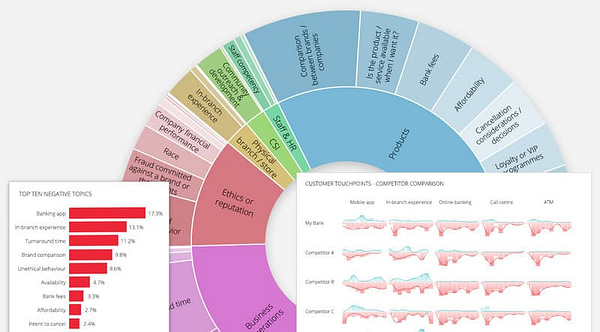The most successful businesses always have one thing in common. They are the ones that know their customers the best.
They’re aware of the language that their customers use and what drives their decision-making processes. They anticipate and care about their customer needs. In the hyper-competitive, connected global economy of the 21st century, it’s more important than ever to deeply understand your customers.
A large component of successful digital marketing is gathering data about your customers, understanding the forces that shape their behaviour and using insights to present solutions that are a better fit than your competitors’. We call these customer insights.
Great audience listening tools
There are a number of powerful audience listening tools that give digital marketers direct access to customer voices. Social media has been a major contributor to the modern customer-centric marketing landscape, and some of these specialist tools help understand large volumes of social mentions. These tools can report on granular metrics and high-level qualitative insights such as sentiment and the topics driving those feelings.
There are opinion mining and analysis tools such as; BrandsEye, Crimson Hexagon, Tableau for visualising big data, Meltwater for PR and media insights and at a more basic level, Sprout Social and Hootsuite for overview metrics. These tools are pretty cool and it’s incredible what your business can learn by just listening in.
Packaging design changes, departmental restructuring, brand messaging corrections, future funnel forecasting and even bad event t-shirt design are all business insights I’ve seen discovered during online listening projects. The impact of this level of feedback means that customer insights have moved far beyond marketings online reputation management and are now helping CEOs with top-level business decisions.

Source: Crimson Hexagon
Customer insight services are still quite costly
At the moment the bigger machine learning tools can take a bit of effort, and therefore staff resource or a hefty consultancy fee to use. They’re useful for clients who are already into data wrangling or have the budget to explore these tools for their full functionality. If you have the budget, then I’d recommend prioritising audience insight work as it will guide your overall marketing activities and business decisions. A recent partnership between an internal and external machine learning company highlights the growing trend of audience analysis which is only set to continue. Read about BrandsEye and Red Box’s proactive contact centre plans here.
But, what about the little guys? Small and medium businesses seem to disqualify themselves from audience insights and most have told me that they’re ‘not quite there yet’.

Source: BrandsEye
You’re sitting on a goldmine
Your colleagues alone are a wealth of ‘marketing topic analysis’ knowledge. Often customer listening starts with listening to your team.
Ask your crew ‘what questions do you get asked the most?’, ‘what misconceptions do you constantly have to correct?’,’ are there any new questions you’ve noticed recently that relate to a new competitor or a future need that’s bubbling on the horizon?’. Give your team some time to prepare, have an hour session with them around a table and you will leave a whole lot more informed.
Digital marketing tasks as entry-level audience listening
The good news is that you don’t actually need a digital marketing agency or a fancy listening suite to get started with the absolute basics of audience insights. Market research tools have never been more accessible and, if you’re resourceful, you’ll be surprised what you can find out about your potential website visitors and customers just by using everyday tools like Google. You also probably have a salesperson who has face-to-face opportunities to listen and email correspondence that is full of customer feedback. If you start thinking about listening more, you’ll find plenty of places to start doing it.

SEO as qualitative research
At Mogul, we do a lot of SEO (search engine optimisation) work. SEO aims to help search engines find your website and rank it number 1 in their search results. Well, that’s the ideal anyway. The complex search optimisation and search marketing space is becoming more competitive. For example, we now compete with human test and voice searches as well as searches from virtual assistants (think Amazon’s Alexa and Apple’s Siri).
More competitors than ever are using paid Google Ads to reach their customers, and the organic search listing real estate on the first page of Google is shrinking due to Google features themselves, so it’s important to think about new tactics to add to your SEO work. In this increasingly crowded landscape, audience insights offer a way to get ahead of your competitors.
Listening will help you show up in Google
The most important task in SEO is to find out exactly what words your customers are using when they search for products or services like yours. But it’s surprisingly common for organisations to optimise or adjust their website pages for words or keywords that their customers are not using at all. Industry jargon and official product names are not always what the customer uses to describe what you offer. Don’t assume that your customers talk about your products or services, or search on Google, using the same words you do.
We’ve been able to increase organic traffic to websites in New Zealand by just correcting that one basic step; using the terms that people are actually searching for. Ask your digital marketing agency for a list of existing search queries found in your Google Analytics (as a result of Google Ads or Google Search Console’s organic data) and see if those are the words that you want to be found with. If they are not, you’ve got a problem.
Another common SEO mistake is to optimise the entire site for the brand name or branded terms. Although this could be a digital marketing strategy for a particular context, it’s usually a bad spend for SEO and will only help those that already know about you to find you online.
Here is a fresh SEO scenario from my work this week that shows how a website can be optimised for the wrong search terms based on industry slang instead of finding out what real people actually search for.
- A company was using shortened versions of the names for their product categories, e.g. rollers vs. roller door. This made sense to them but it was totally irrelevant for people searching Google. The word ‘rollers’ attract all sorts of random broad traffic and make it almost impossible to rank for. Conversely, ‘roller doors’ is much more targeted, is closer to the person’s search intent, is much more likely to rank number 1, and will deliver significantly more quality traffic.

Source: Meltwater
Here’s an easy audience insights tip
If you open a Google window and type in your industry terms into the search field, you’ll notice a dropdown list of alternative suggested terms appear. Without paying for expensive SEO monitoring tools you can use these Google Suggested Searches to learn more about your customers’ search intent, related topics and about search volume presence in your country as well. Try variations for offerings, products, client needs, industry terms and terms that competitors are using. You will be amazed at the insights you can gain.
Using Google to identify industry topics and trends
There are two things you’re looking at here. Firstly, you are learning new term variations and second, you are looking at the order in which they appear. These give you an idea of the popularity of each search query. Try a few of the suggested searches until you see your competitors popping up in the search results this is when you’ll know you’re on the right track. Don’t forget to include search queries from all stages of the sales funnel as well as common natural-language questions as these are becoming increasingly important for growing queries as voice search becomes more common.
The featured snippets (Google question drop-down feature) can guide the content on your site as these are common questions related to your theme.
Here is what displays when I searched for ‘digital marketing’.

This tells me that some people are interested in what the job involves, some folk would like to know the different tactics or opportunities and others don’t know what digital marketing means at all. This can be a manual and time-consuming task, but an hour of doing this should reveal some interesting user insights to get you started.
Need help listening to your customers or ranking in Google?
I hope you found that quick tip useful and were able to do a bit of a checking to see if your site is showing up in Google for popular and relevant search terms within your industry. Google is all about serving relevant information to their users, they want to match the most useful website information to the searcher’s intent. Keep that in mind when you’re writing content and always ask yourself ‘what is my audience actually looking for online and what words are they using?’
Key take away: listen more.
Start thinking about how you can learn more about your customers during business as usual. Are you talking more than you’re listening (both face to face and on social media)? If you answered the former then that’s a good indication that you’re not listening at all. Are you looking at your Facebook Insights, Google Ads and Google Analytics search queries to see what search terms are bringing you the best traffic? Are you using Google suggested searches and Google Trends to find the popular topics that people are searching for in your industry?
If you’d like to know more about implementing the great search insights or if you need us to help you with customer listening, voice search considerations or any other digital marketing activity, then we’re happy to chat when you’re ready.

